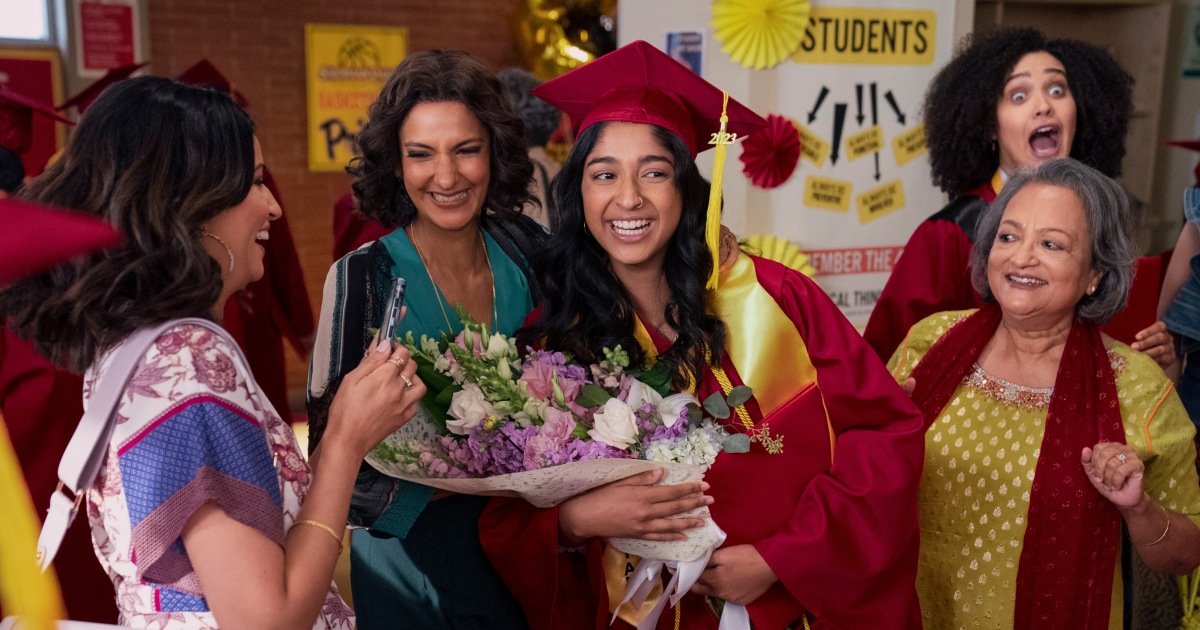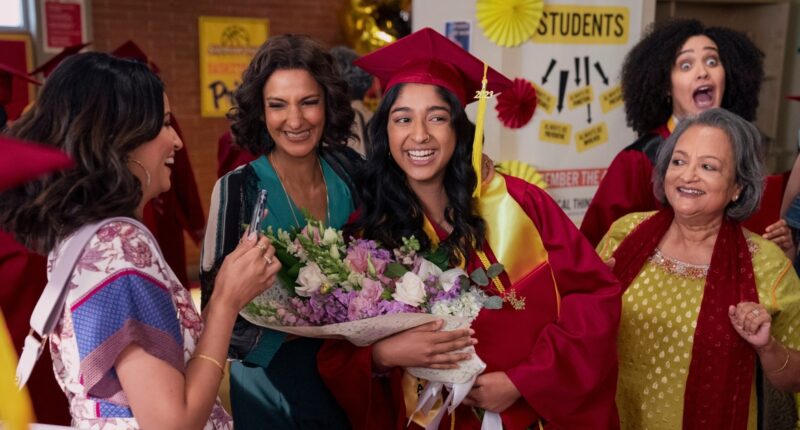
There’s a bittersweetness for fans as they sit down for the final season of Netflix’s “Never Have I Ever,” they say. Watching now-high-school-senior Devi Vishwakumar’s messy, boy-crazy antics play out one last time, they’re savoring every moment of what they feel is the first true South Indian American story told on TV.
“It’s because of its specificity that it was groundbreaking,” said Snigdha Sur, editor-in-chief of South Asian American publication The Juggernaut. “It’s not just about an Indian American family; it’s specifically about a Tamil American family in California’s suburbs where there’s a breadwinning mother and a father that has passed away.”
They’re preparing to send off not only a beloved main character — but also a watershed piece of media that they hope changed the appetite for and prevalence of stories like it, they said. In a post-“Never Have I Ever” world, some wonder: How long will they have to wait for something like it to fill the void?
For those who share Devi’s Tamil American identity, the show was an especially significant first.
Created by Mindy Kaling, “Never Have I Ever” follows a multigenerational family of Tamil women in Southern California. Devi, played by Maitreyi Ramakrishnan, navigates high school friendships, crushes, spirituality and the recent death of her father. In season four, she prepares to graduate and leave all she knows behind.
The show explores the parallel experiences of her mom (Poorna Jagannathan), grandmother (Ranjita Chakravarty) and cousin (Richa Moorjani).
A comedy whose premise was rooted in grief and teenage cultural panic, “Never Have I Ever” knew what it was from the beginning, Sur said.
Capturing the Tamil American experience
While previous shows and movies with Indian characters might have used a mix of traits and languages from the North and South, characters in this one used decidedly Tamil phrases, with Devi’s mom fondly referring to her as “kanna,” a Tamil term of endearment, and her grandmother promising to make medu vada, a popular South Indian breakfast food.
It’s always been a show that refused to explain itself, Sur said.
“It’s unabashed in its inside jokes,” she said. “It’s not afraid to say a statement in Tamil; there’s Tamil words being thrown out all the time. … And we’re not going to translate this word for you.”
It made it easy for Tamil American families to sit together and watch it, taking in its similarities to their lives with its multigenerational cast of women. Sherene Joseph, 45, is a Tamil American mom of two who lives in the suburbs of Dallas. She started watching the show with her kids when her daughter was a freshman in high school.
“Being a girl from Chennai myself, I’m always interested when I see Tamilians on the screen,” she said. “It really resonated because it was the first time that we were seeing representation of Tamilians on a TV show in the United States. Every time you see Indian representation, it’s very stereotypical. … India is not just butter chicken and naan.”
Joseph said when her family watched the first episode together three years ago, seeing her culture — not just as a Tamilian, but as a mom to a first-generation family — drew her in.
Karthick Ramakrishnan, founder and co-director of AAPI Data and the father of two boys, found uncanny similarities between the Vishwakumars and his own family. They too are Tamils living in the suburbs of Southern California, with a similar religious and language background.
But what sparked perhaps more conversations in his household was the exploration of biracial stories in characters like Paxton Hall-Yoshida, one of Devi’s love interests, who in the early seasons explores his grandfather’s incarceration in a Japanese internment camp.
“It’s not only about seeing characters like Devi or characters like Nalini (Jagannathan) that might remind us of certain aspects of our personalities as parents,” he said. “But also, the Paxton character and how he navigates his identity.”
“Never Have I Ever” brings these big concepts up without being heavy-handed, he said. Questions of identity and inclusivity are on the table, but Devi and her friends aren’t politically perfect; in fact, they’re still figuring out right from wrong.
“The show showed how you can do something that is inclusive without being preachy,” Ramakrishnan said. “People — including Asian Americans and even South Asians — are getting used to hearing that kind of very particular part of South Asia that they might not have been exposed to before, but it’s done in a light way, in the sense that it’s both a light touch and it’s done with humor.”
What’s next for South Asian American stories?
The show gave Americans visual language about South Asian culture that many never would have had a window into otherwise, Sur said, their inexplicable love for Ferrero Rocher chocolates and Trader Joe’s, for example.
But she worries that the finale of “Never Have I Ever” will mean the last taste of that content for a while.
“What I fear is that Hollywood still views these stories as risky,” she said. “Do you know what’s going to be out after ‘Never Have I Ever’? I don’t.”
Creator Kaling has faced criticism over the last few months for heavily featuring white male leads and love interests in her stories about brown women. In the “Never Have I Ever” finale, both Devi and her grandmother end up with white men.
While Kaling’s influence means more South Asian faces on-screen overall, Sur fears that Hollywood is only betting on one person to make hit diaspora TV. There need to be more voices, she said.
For Ramakrishnan, that means more caste and class diversity, too.
But before looking into the future just yet, South Indian American fans say they want to linger here for a second, relishing the final episodes of a show that saw them more than any piece of media that came before it.
“I think it shows another way in which the Asian American community and the South Asian community has arrived,” Ramakrishnan said. “We don’t need to water things down too much to make it palatable for white audiences or mainstream audiences.”
Source: | This article originally belongs to Nbcnews.com









